
Another day, another flight, and I'm starting to think...lessons.
Geoff unloaded the motorbike's big sidecar, full of tandem seats, paragliding canopies and camera equipment. He handed the goods to everyone else until I complained.
"But you're a guest!" he argued.
Yep. A paying one, too, and I also like to work for my joy. The day was breathtakingly hot. Our little group had motored to the zigzagging hiking lane which headed straight up a steep incline to the launch zone, just over an inaccessible beach below. Here, the conditions were perfect to grab some excellent updrafts and winds which would send us spiraling skyward.
Laughing, Geoff tossed a canopy bag at me. Big, clumsy, but relatively light. All I had were thin strings, which I wrapped around my neck so that I could use my hands for balance. I had no idea what the hike would entail, so hands-free was a good idea.
Yeah, it was. The lead pilot disappeared into the bush ahead. An older Swedish man and I hiked up behind him, the trail thinning, the hike steeper, the brush scraping our sweaty faces.
I paused for a moment to take a photo and adjust the strings which were threatening to throttle me. I vastly prefer backpack straps but there you go. You manage. Geoff does this eight times a day when this is his launch spot. I'm only doing it once.
We continued up, the trail thinning even more, the heat oppressive, the sweat streaming into my eyes.
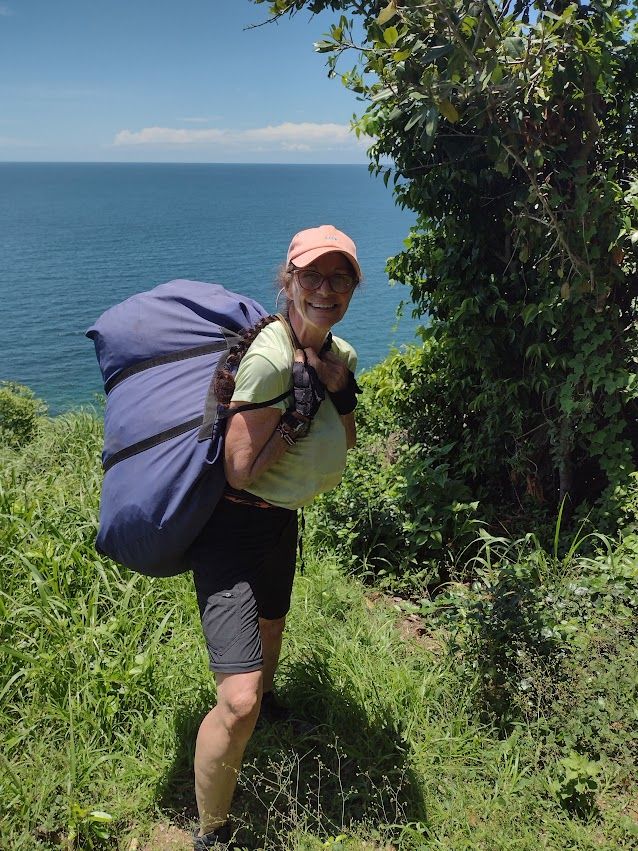
Finally I saw the bright red of one of the gear bags up ahead on the left. I swerved to find the clearing, marked by a heavy plastic covering, which yesterday Geoff had pointed out to me during my first paragliding run here.
A thin pole to our left featured two strands of pink plastic. That was our wind sock. To the right, around the corner and obscured by the thickly-forested hills, Samae Beach, likely our landing spot. Depending on the winds.
Life for a paraglider always depends on the winds.
Our small lot gathered on the top of the plastic, each of us assessing next steps. I was first in line today to leap off the cliff, attached to Ta this time. Ta is Thai, a pilot for seven years. Geoff trained him and others to help run his outfit:

Geoff's in his early fifties, once enamored of becoming an RAF fighter pilot. As I mentioned in an earlier story we are both veterans, we both shared that dream, and it escaped us both. Love of flying didn't leave either one of us.
While Geoff stuck with paragliding, I've explored everything from bungee jumping to skydiving to piloting to, well, any excuse to get airborne, with the exception of those idiot stunts guaranteed to get you killed. Of course there are those who would claim that all those things I just listed fall into that category but there you go.
Like all those focused enough to stick with one thing, Geoff's gotten very good at this. Good enough to be an instructor, so that more than a few of the gents who joined us this day were here for extended periods working on their skills. About the only way to subsidize this kind of Jones is to get good enough to train, buy and sell gear, repair it and run an outfit like this.
The launch area is only big enough to accommodate a single canopy, whose great crescent arc of brightly-colored silk is large to provide enough lift for two people. Ta is about 82 kg, I'm 54. Today the winds are brisk, and the second we are off the edge of the cliff we have to turn sharp right to face into it.
That's not for rookies.
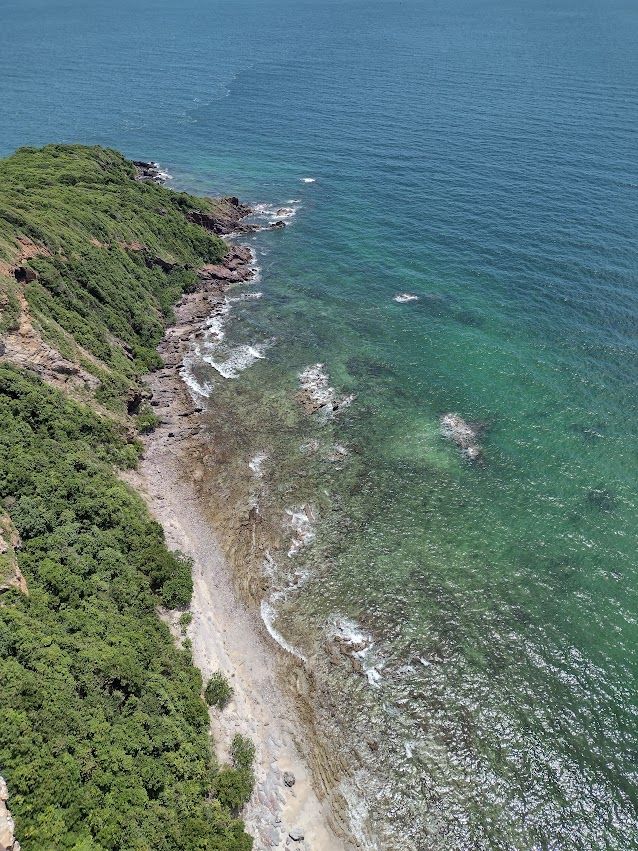
Below is Pha Na Yuk Beach, which is little more than a high, rocky cliff with some rough rocks below us. Not a place you want to attempt a landing.
Ta hooks himself up to the canopy, which for now lies flat on the plastic. I maneuver in front of him. Another pilot attaches all the hooks and clips so that I can slip backwards into the bucket seat the moment we are airborne. Behind us, Geoff and others get ready to lift the canopy so that it can collect the air.
The moment it does, the conditions being perfect, Ta and I step forward. The winds capture the canopy so swiftly that the typical running start was wholly unnecessary. In seconds we are rising, the patch of black plastic turning into a chessboard square below us, the next pilot getting ready to launch.
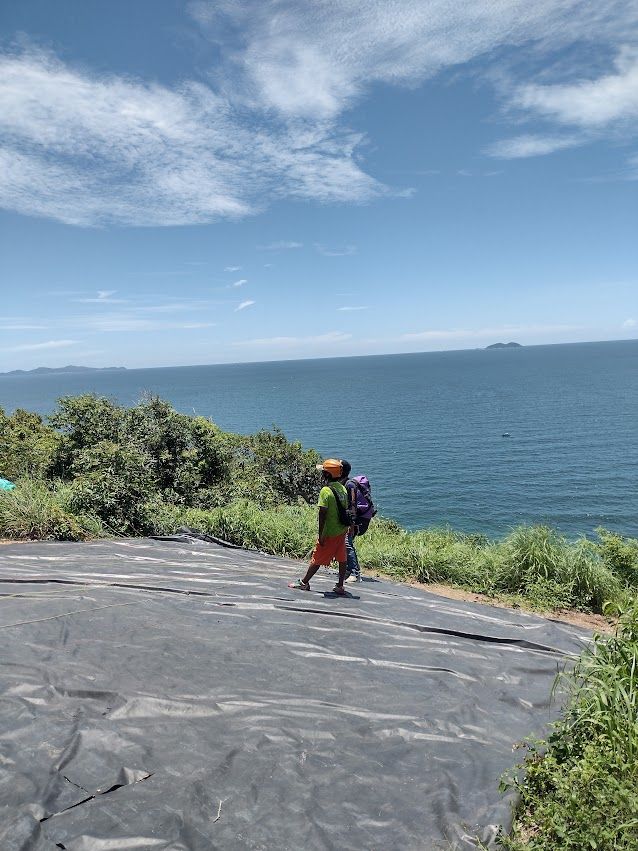

While I would prefer to do such things solo, I don't have the training. I'm sorely tempted, though, for as I have steadily reduced my belongings to less and less, as have the men I met whose love of the sport drew them here, the idea of returning to air sports really is, well, addictive. Instead of a mortgage, at some point soon I will have a wholly different set of options as to where my funds get invested.
Dave, an Aussie, Steve, an American and a few others were there for the fine flying days. Some are dedicated pilots who were captured by paragliding's predecessor, hang gliding, back in the Seventies when I was first learning to jump. Hang gliding, the use of a delta wing, is inherently more dangerous than paragliding.
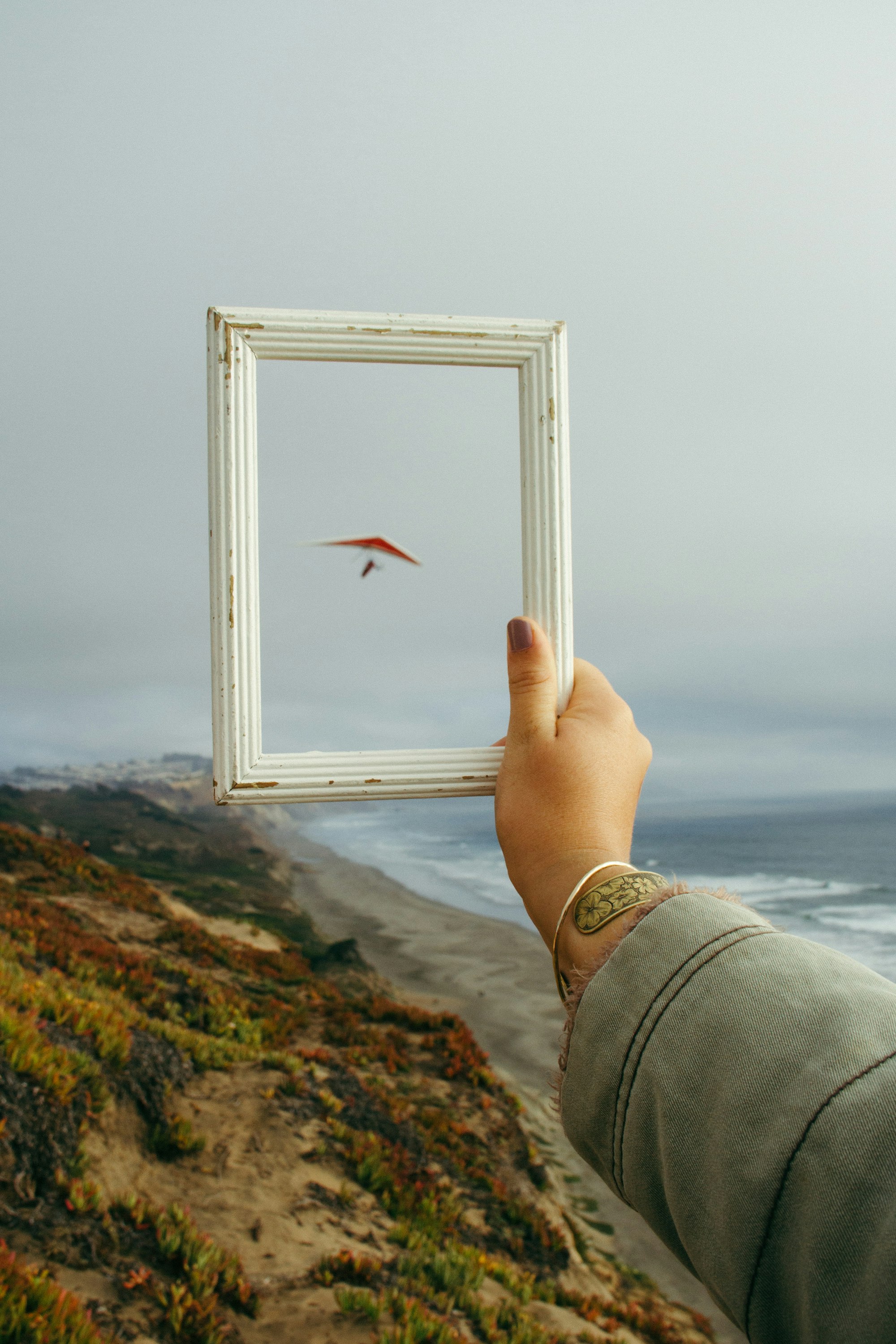
All these sports have evolved. Some have been motorized. Dave also paramotors, which gives you more options to stay aloft (as long as you have forward motion over the camber of the wing you get to keep flying, no matter the source).
For those of you who are not pilots, that is why, if your plane stalls, against all otherwise knee-jerk logic, you point the nose down. The moment you do that and gain speed, the flow of air over the wing's curved shape creates lift, and you can ease out of your dive. That is, of course, assuming you stalled with enough altitude for you to recover.
With a motor, that adds complexity, more parts, noise, weight and complications. When it's working it also means that if indeed you do hit a bubble of no wind, you have options. I've flown a powered glider and can attest to the difference between motor on and motor off in the same aircraft. I understand the purists who only want to ride the wind.
Unlike airplanes, there is no such thing as a go-around on landing for any craft solely dependent upon winds and rising air currents to stay aloft. Hang gliders have a notorious reputation for stalling, and those pilots can pay a rough price if they aren't high enough for a reserve chute to deploy.
Those of us who skydived actively would make jokes about how you could tell our "boogies", or gatherings of the sport's aficionados, apart. Hang glider pilots, we said, always had knee braces or crutches. Something to that.
However none of these sports is for fools or for the inherently unsafe. Geoff reported that there had been a few deaths (not students, experienced pilots), usually involving what Dave later explained he calls "red flags." As a former policeman, Dave's perspective on safety and preparation are likely closer to what Geoff and I would consider as military veterans: lots and lots of advance work and training, site checks, and a clear-eyed assessment of potential dangers.
With that, the willingness to call off the adventure when conditions are clearly not in your favor. When people do it anyway in search of that epic tale, that usually doesn't entail a good ending.
That led to a lively discussion of those times when we didn't behave so responsibly. A late night, heat, over-confidence. The fact that all of us were still there spoke to a combination of pluck and luck, but also the realization of that the next time, we might not be so fortunate. Those who survive those mistakes tend to fall into two camps:
Those who will never repeat them.
Those who are emboldened by them.
The latter don't tend to last long.
Air sports are incredibly unforgiving of stupidity, showoffs and smartasses. Which is why when I was in Mendoza, Argentina, a few years back, I was delighted to see that my paragliding pilot was, like Geoff, grey at the temples. It's also why, if I am at a drop zone or any facility where I see that kind of behavior, I either leave, or find someone far more sober with whom to do my air sports.
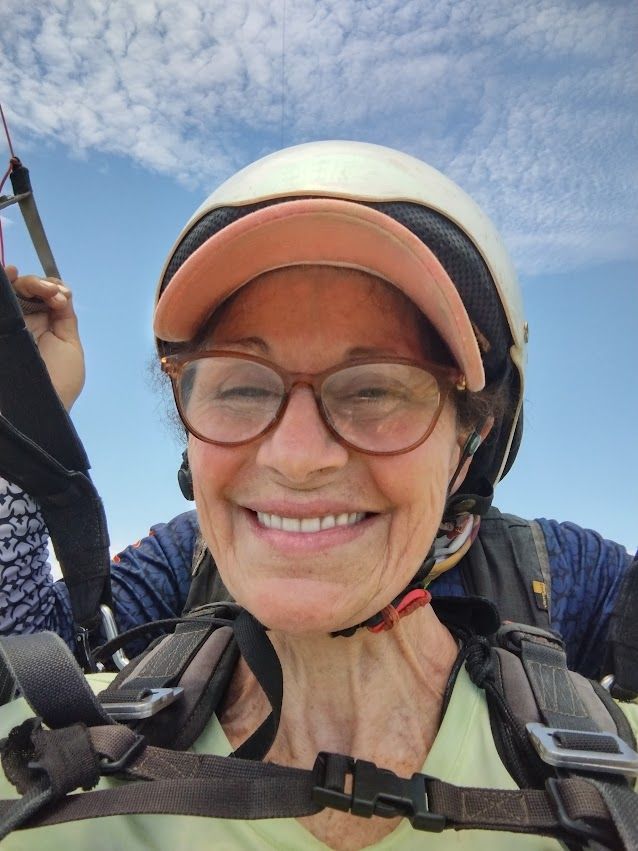
For now however, all I had were Ta at my back, managing the toggles on the canopy as we rose in silent spirals, and a vast vision of sky and beach and ocean. Ta watched the waves below us for sea life and kept a careful eye out for others who soon joined us in the rising air.
From the very first time I ever let go of the strut of a Cessna 150 which had been stripped down to allow skydivers to cram inside, I have been hooked. That first ride skyward is for most, a doozy, full of apprehension and grotesque imagings of what might go wrong. That was back in 1973, when today's pillowy-soft "squares" were considered far too high-tech and dangerous for beginners. Now those enormous mattresses of lift are the standard, making even lousy landings a lot softer.
As Geoff said to a prospective new client yesterday, your misgivings only last about three seconds, if that. Once aloft, the sheer overwhelming joy of no longer being attached to this bubble by gravity tends to change everything...or, you can't wait to get back down. It depends. If you're that frightened, the landings can feel terrifying.
The landings, however, aren't the point. Once anyone has gone aloft, at least if you've got this gene, it's likely going to be a lifelong journey to keep going aloft. For me that was a whole lot of ways, including the demo planes we used to have which practiced for air shows where I started my skydiving career in rural Viriginia back in 1974.
That of course doesn't include this guy:
Kindly, I am not that kid. I have always had such a girlie hardon to go max Mach in a fighter jet. The one Air Force pilot who offered, demanded a payment that was highly inappropriate, so that one slipped by.
I already have 70 hours' flying time, 131 skydives and untold other adventures, including a perfect Swannie off the tallest bridge in Croatia. Off the coast of the North Island of New Zealand in 1984, my pilot trained me to do barrel rolls and loops in his aerobatic plane. I love that stuff.
What's truly impressive is careful competence. As Ta and I rose, I closed my eyes and soaked in the feelings of gentle turbulence. For land-lubbers, turbulence in an aircraft is panic-inducing. One of the great gifts of being aloft in a very small airplane or rig like this is that turbulence is part of the ride. Obviously you don't seek out the rough stuff, as it might drop you pretty fast or collapse your canopy in extreme conditions.
However, learning to relax in the bumps is as much learning to trust the air as it is learning to trust yourself in the embrace of the air. It's a liquid, just as water is. The cross winds and thermoclines are part of the conditions. You learn as a boat captain or scuba diver to deal with the unpredictability of the ocean, the swift currents and radical changes in temperatures. This is similar but for the altitude.
As Geoff explained, the deaths he witnessed involved experienced pilots. This sadly is too common. For example, those with tens of thousands of skydives are among those whose trust and familiarity in the air soothe them into thinking they have done all the essential checks. All is well, until it isn't.
Having experienced two total malfunctions, I can attest to how swiftly things can go wrong. That I am still here attests to the quality of the training I received from my instructors. They demanded that I practice until my response to said emergency was so instinctive I didn't have to think.
You don't have TIME to think. In both instances I pulled my reserve so swiftly I have no recollection whatsoever of doing so.
After plenty of gorgeous time swirling in the bright blue sky above gemstone waters and rock-encrusted beaches, and waving at the other two pilots as we passed each other in God's swings, Ta slowly aimed at Samae Beach, our landing zone.
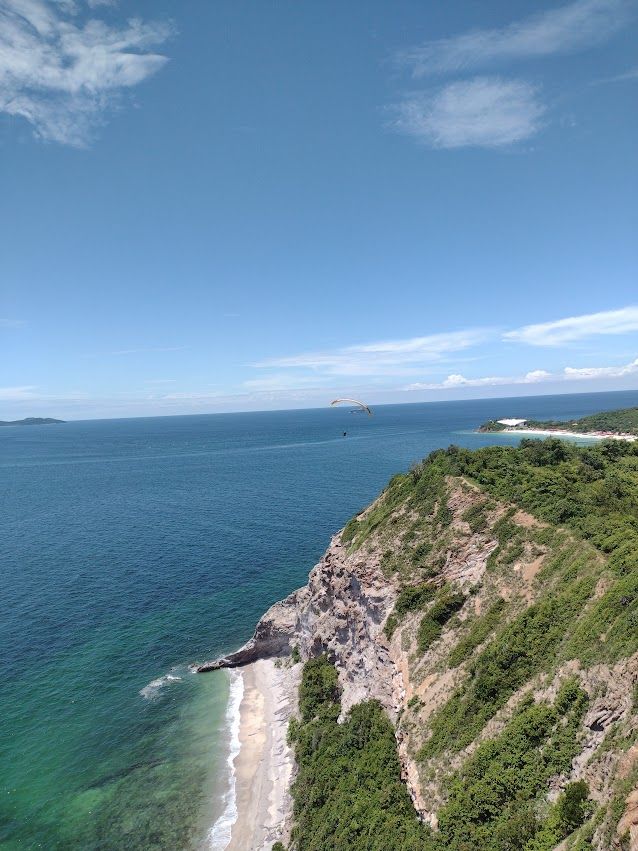
A good pilot knows how to land, which involves the utmost sense of timing and gentility. I have had my share of bad landings, including landing with instead of into the wind. You don't repeat that. As with all air sports you have to stall your craft, and just so, so that ideally you (and your passenger) need only to step onto the ground as though coming out of your kitchen.
When you have a background of some pretty spectacular landings, all your own fault, by the way, then the two landings I enjoyed were the kind to write home about. Or at least to write about here. Those who have done enough air sports and who have both committed and survived bad landings appreciate the good ones vastly more than those passengers who clap when a pilot safely sets his craft down in a routine airline landing.
Takeoffs and landings are the singular points of danger in any air sport, no matter which. That is why being utterly and totally focused on safety, competence, potential red flags and any factors which could affect your flight negatively are imperatives, not options.
Is this for you? Well, look. Unless you're a mild lunatic like this author, perhaps not. But just once? I highly recommend it. The perspective you gain from being aloft, the appreciation of the earth's curvature (YES it's round) and the insignificance of our role upon it in a universe so vast as to confound any understanding makes it worth it.
Such humility is a fine antidote to today's rampant hubris. But that's just me.
If you come here, the price is half what you'd pay in the US. There's that. Any way you call it, heading unto the breach, with or without Prince Harry (NO not that one, Shakespeare's) is, well,
HELL YEAH.

Dear Walkabout Saga Reader:
If my work appeals to you, may I kindly invite you to consider joining those Patreon supporters whose generosity keeps the gas in my tank as it were. Those supporters get to dictate my content calendar, we engage as a community, and this website and its content acts in service to our collective best selves.
You can explore that option here.
However you decide to partake of my writing, thank you.

Comments powered by Talkyard.